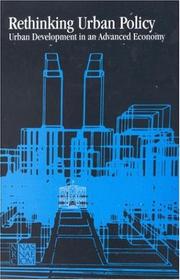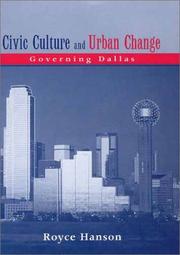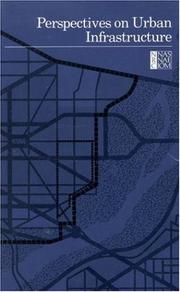| Listing 1 - 4 of 4 |
Sort by
|

ISBN: 0309034264 9786610245871 1280245875 0309533864 0585155682 9780585155685 9781280245879 6610245878 9780309533867 9780309034265 9780309078627 Year: 1983 Publisher: Washington, D.C. National Academy Press
Abstract | Keywords | Export | Availability | Bookmark
 Loading...
Loading...Choose an application
- Reference Manager
- EndNote
- RefWorks (Direct export to RefWorks)
Urban policy --- Urban economics. --- Cities and towns --- City economics --- Economics of cities --- Economic aspects --- Economics

ISBN: 0814330800 0814337473 9780814337479 9780814330807 9780814330807 Year: 2003 Publisher: Detroit Wayne State University Press
Abstract | Keywords | Export | Availability | Bookmark
 Loading...
Loading...Choose an application
- Reference Manager
- EndNote
- RefWorks (Direct export to RefWorks)
BUSINESS & ECONOMICS --- Economic Conditions --- Government - U.S. --- Law, Politics & Government --- Local Government - U.S. --- Political culture --- City planning --- Urban policy --- History --- Dallas (Tex.) --- Politics and government --- Economic conditions --- Cities and state --- Urban problems --- Cities and towns --- Civic planning --- Land use, Urban --- Model cities --- Redevelopment, Urban --- Slum clearance --- Town planning --- Urban design --- Urban development --- Urban planning --- Planning --- Government policy --- Management --- City and town life --- Economic policy --- Social policy --- Sociology, Urban --- Urban renewal --- Land use --- Art, Municipal --- Civic improvement --- Regional planning --- Culture --- Political science --- City of Dallas (Tex.)
Book
ISBN: 9781501705250 9781501708077 9781501708084 1501708082 1501708074 1501705253 Year: 2017 Publisher: Ithaca, N.Y. Cornell University Press
Abstract | Keywords | Export | Availability | Bookmark
 Loading...
Loading...Choose an application
- Reference Manager
- EndNote
- RefWorks (Direct export to RefWorks)
Land-use policy is at the center of suburban political economies because everything has to happen somewhere but nothing happens by itself. In Suburb, Royce Hanson explores how well a century of strategic land-use decisions served the public interest in Montgomery County, Maryland, a suburb of Washington, D.C. Transformed from a rural hinterland into the home a million people and a half-million jobs, Montgomery County built a national reputation for innovation in land use policy-including inclusive zoning, linking zoning to master plans, preservation of farmland and open space, growth management, and transit-oriented development.A pervasive theme of Suburb involves the struggle for influence over land use policy between two virtual suburban republics. Developers, their business allies, and sympathetic officials sought a virtuous cycle of market-guided growth in which land was a commodity and residents were customers who voted with their feet. Homeowners, environmentalists, and their allies saw themselves as citizens and stakeholders with moral claims on the way development occurred and made their wishes known at the ballot box. In a book that will be of particular interest to planning practitioners, attorneys, builders, and civic activists, Hanson evaluates how well the development pattern produced by decades of planning decisions served the public interest.
Environmental planning --- Economic geography --- urban planning --- land use --- suburbs --- urban management --- Maryland --- City planning --- Cities and towns --- Civic planning --- Land use, Urban --- Model cities --- Redevelopment, Urban --- Slum clearance --- Town planning --- Urban design --- Urban development --- Urban planning --- Land use --- Planning --- Art, Municipal --- Civic improvement --- Regional planning --- Urban policy --- Urban renewal --- Political aspects --- Government policy --- Management --- Silver Spring (Md.) --- Politics and government. --- Maryland [state]

ISBN: 0309034396 9786610245864 1280245867 0309541328 058514429X 9780585144290 9780309034395 Year: 1984 Publisher: Washington, D.C. National Academy Press
Abstract | Keywords | Export | Availability | Bookmark
 Loading...
Loading...Choose an application
- Reference Manager
- EndNote
- RefWorks (Direct export to RefWorks)
In this provocative volume, distinguished authorities on urban policy expose the myths surrounding today's "infrastructure crisis" in urban public works. Five in-depth papers examine the evolution of the public works system, the limitations of urban needs studies, the financing of public works projects, the impact of politics, and how technology is affecting the types of infrastructures needed for tomorrow's cities.
Infrastructure (Economics) --- Urban policy --- Capital, Social (Economics) --- Economic infrastructure --- Social capital (Economics) --- Social infrastructure --- Social overhead capital --- Economic development --- Human settlements --- Public goods --- Public works --- Capital
| Listing 1 - 4 of 4 |
Sort by
|

 Search
Search Feedback
Feedback About UniCat
About UniCat  Help
Help News
News